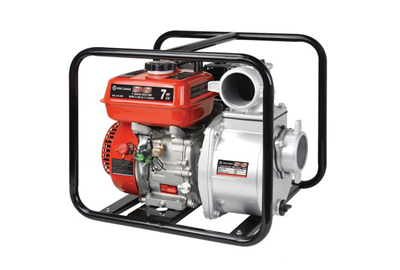Moving water has always been one of engineering’s most persistent problems. Today’s water pumps solve it with precision, power, and portability. Behind every drained basement, irrigated field, and circulating pond is a pump doing the work that buckets never could. These machines move water quickly, reduce damage, and support everything from home upkeep to large-scale operations. You’ll see them at work in gardens, farms, flood zones, and even high-rise buildings and anywhere water needs to move, and gravity isn’t enough.
How Does a Water Pump Work?
Most water pumps use a motor to get the job done. Powered by electricity, gasoline, or a rechargeable battery, the motor creates suction that pulls water in through one side and pushes it out the other. There are two main ways these pumps move water. A centrifugal pump uses a spinning impeller to generate velocity, pushing water outward in a steady, high-volume flow. It’s ideal for clean water applications and is widely used in residential, agricultural, and commercial systems. ‘How do I prime a water pump?’ is a common question. Priming usually means filling the pump housing with water to remove air so suction can begin. A positive displacement pump works differently. It moves a fixed amount of water by applying mechanical pressure, making it better suited for high-pressure or precision tasks in industrial settings.
Manual water pumps take a simpler approach. They don’t use a motor and rely entirely on physical effort. For those wondering, what is a requirement of a manual water pump, the answer is simple: you have to pump a handle to create the suction needed to move water through the system.
Types of Water Pumps
Submersible Pumps
A submersible water pump is built to operate underwater, using a sealed motor to protect against moisture and debris. These water pump submersible pump models are commonly used to drain clear water from flat surfaces, shallow containers, or flooded indoor areas. They’re efficient, low-maintenance, and capable of moving large volumes of water with minimal effort. While many use float switches to control operation, some models feature a dry-run safeguard that automatically shuts the pump off when no water is detected. Cordless designs are also available, offering more flexibility in areas without direct power access.
Centrifugal Pumps
Centrifugal pumps rely on a spinning impeller to deliver a steady, high-flow output, making them well-suited for continuous use. They are efficient, durable, and often used in commercial sites, farms, and large outdoor areas where rapid water movement is needed. Most centrifugal pumps, including self-priming models, require an initial priming step before operation. Understanding how to prime a water pump is important. You need to fill the pump housing with water through the priming plug or inlet to eliminate any trapped air. Air inside the system disrupts suction and prevents the pump from drawing water effectively. Without this step, the pump may overheat or experience long-term damage.
Transfer Pumps
Compact and easy to move, transfer pumps are designed for quick water removal tasks such as draining water heaters, small storage tanks or clearing shallow puddles. Most connect to a standard garden hose and are available in electric, manual, or battery-powered options. While many are suited for light-duty household use, some cordless models, like those powered by 18V battery systems, offer higher flow rates and greater lift capacity.
Garden or Utility Pumps
Garden water pumps are designed specifically for moving clean water from storage sources like rain barrels, cisterns, or shallow wells to where it’s needed. That often means gardens, lawns, or outdoor taps. This type of water pump is ideal for homeowners who collect rainwater and want a sustainable way to irrigate their landscape. Many models provide moderate pressure and flow suitable for running sprinklers or drip systems without damaging plants. They offer a practical way to lower water bills, conserve resources, and maintain healthy growth during dry weather.
Dirty Water Pumps
Dirty water pumps are designed to handle more than just clean water, making them a versatile option for everyday drainage tasks. Some models can manage small debris or particles up to 1 inch, using reinforced impellers and sealed components to prevent clogging and wear. While not built for heavy industrial cleanup, they perform well in settings like flooded gardens, utility pits, or rainwater tanks, especially where access to power is limited. Features like flat-suction capability, dry-run protection, and various power modes add to their reliability and convenience for light to moderate use.
On Demand Water Pumps
On demand water pumps automatically start and stop based on water use. They’re designed to sense pressure drops in the line, turning on when a tap is opened and shutting off when it’s closed. This makes them ideal for RVs, boats, off-grid homes, and any setup where water needs to be available without constantly running the pump.
What to Look for in a Water Pump
Power Source
Water pumps come in different power types, and your choice depends on how and where you plan to use the pump. Electric pumps are a solid option for indoor tasks or anywhere with a reliable power outlet. They tend to be quiet and easy to maintain. Battery-powered models give you more flexibility, especially for quick jobs or locations where running a cord would be a hassle. These are great for garden use, rain barrels, or light cleanup. Gas-powered pumps offer more strength and are better suited for outdoor or remote work. They’re often used for larger jobs that need more pressure or a higher flow rate.
Flow Rate
Flow rate is measured in gallons per minute, or GPM, and tells you how quickly the pump moves water. A higher GPM means you can move more water in less time, which is useful for draining pools or large tanks. For smaller tasks, a lower flow rate may be more practical and help save battery or fuel. When comparing pumps, check if the GPM fits the kind of work you’ll be doing. Bigger jobs usually need higher flow, but that also means more power use.
Head Height
Head height refers to how high the pump can push water vertically. This matters when you’re moving water uphill or into a raised container. If you’re pumping from a lower tank to a garden on a slope, the pump’s head height needs to be greater than that elevation difference. It’s useful for deeper setups like pits, tanks, or wells where the pump needs to lift water before discharge.
Hose Compatibility
Before buying, make sure the pump’s inlet and outlet sizes match your hoses. Some pumps include adapters for standard garden hoses, while others may use threaded or specialized fittings. Get the right fit to avoid leaks, poor pressure, or wasted time during setup. Always check the specs so you know what you’re working with.
Durability
Look for pumps with tough housing, sealed components, or materials that resist rust and wear. Some models use plastic, but heavy-duty versions may have aluminum or cast iron parts. If you’re wondering how long do water well pumps last, the answer depends on how often they’re used and how well they’re maintained. Many can last eight to fifteen years or more if properly cared for.
Looking for reliable water pumps backed by decades of expertise? Visit Jean-Claude Cayer Enterprises for top brands, expert advice, and trusted service across retail, wholesale, and industrial needs. Since 1988, we’ve helped professionals and homeowners find the right tools.











